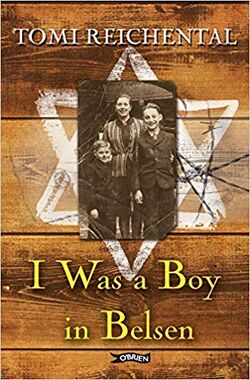Tomi Reichental (M / Slovakia, 1935), Holocaust survivor
Tomi Reichental (M / Slovakia, 1935), Holocaust survivor
Mikulas Reichental (M / Slovakia, 1931), Holocaust survivor
- KEYWORDS : <Slovakia> <Bergen-Belsen> <Liberation of Bergen-Belsen>
- MEMOIRS : I Was a Boy in Belsen (2011)
Biography
Mikulas (18 Dec 1931) and Tomáš "Tomi"(26 Jun 1935) Reichental were born in the village of Merašice (near Piestani) in Western Slovakia in 1935 to Jewish farmers and lived with their family on their farm. Under Nazi occupation, to avoid deportation they went into hiding but Tomi was captured in October 1944 with other members of his family. They were taken to Bergen-Belsen concentration camp where they stayed until the camp was liberated by the British on 15 April 1945. After the war Tomi moved to Ireland.
Sources
- USHMM Database (yes)
Book : I Was a Boy in Belsen (2011)
- I Was a Boy in Belsen (Dublin [Ireland]: O'Brien, 2011).
"In the last couple of years I realised that, as one of the last witnesses, I must speak out'. Tomi Reichental, who lost 35 members of his family in the Holocaust, gives his account of being imprisoned as a child at Belsen concentration camp. He was nine-years old in October 1944 when he was rounded up by the Gestapo in a shop in Bratislava, Slovakia. Along with 12 other members of his family he was taken to a detention camp where the elusive Nazi War Criminal Alois Brunner had the power of life and death. His story is a story of the past. It is also a story for our times. The Holocaust reminds us of the dangers of racism and intolerance, providing lessons that are relevant today."--Publisher description.
Irish Children of the Holocaust
Tomi Reichental was born on a small farm in Piestany, Czechoslovakia, in 1935, the year of the anti-Jewish Nuremberg laws. The Slovak government was a puppet administration of the Germany Nazi party and actively aided Nazi policies. As young children, Tomi and his brother, Miki, had to wear a yellow star of David on their clothing. Going to school they suffered bullying, taunts, assaults and humiliation from their peers, simply for being Jewish. Eventually, Jews were no longer allowed in the school.
When an SS unit stormed the village, Tomi’s father was taken away and bundled onto a cattle truck bound for Auschwitz. He managed to escape by jumping from the moving vehicle with another man. He then joined the local resistance and fought with the partisans during the war.
In November 1944, despite having false papers, Tomi was arrested along with his mother Judith, brother Miki, grandmother Roselle, aunt Margot and cousin Eva. They were deported to Bergen-Belsen concentration camp in northern Germany.
In his ‘new home in hell’, each morning Tomi faced roll call in the freezing cold. He would become inured to the stench of the rotting corpses piled high around the camp, eventually playing among them, taking care to keep out of the way of the Nazis who practised their marksmanship on human targets. He watched as hundreds of people around him fell ill and died from typhus, diphtheria, tuberculosis or from starvation. Tomi credits his survival to the fact that he was one of the group the Germans showed the outside world as proof that the prisoners were well cared for. He was given extra rations before being displayed to outsiders.
One day in April 1945 the German guards disappeared from the camp and another group of soldiers, with movie cameras and food rations, arrived. The camp had been liberated. Many people, whose stomachs had shrunk from months or years of malnutrition, were unable to tolerate the protein-rich army rations and died. Despite the Allies’ best efforts the deaths continued for some months.
Tomi’s grandmother passed away in Bergen-Belsen. Tomi, his mother, brother, aunt and cousin Eva survived. Tomi lost 35 close family members in the Holocaust. He came to Ireland in 1960 and has lived here ever since.
In 2007 Tomi returned to Bergen-Belsen for the first time in 63 years as part of a documentary being made about him called Until the Tenth Generation. He and his brother, Miki, and cousin, Eva, attended the opening of the BergenBelsen Museum and laid a memorial plaque there for their grandmother.
"We arrive at the site and walk slowly up to an open area with forest all around us. It is now a peaceful, tranquil place but for me, 63 years too late! When I arrived in 1944 it was ‘hell on earth’. This open area represented an open graveyard. The memories flood my mind – back then there were corpses lying all around as far as the eye could see. The enormity of this place hits us when we pass the mounds of earth which are the mass graves containing thousands of corpses. Each one has a concrete plaque stating the number buried within: 2,500, 1,000 and on and on. It is, in fact, one of the largest cemeteries in Europe. There are over 70,000 murdered victims buried within these mass graves: 20,000 POWs and 50,000 Jews. We stopped at the Jewish memorial monument, where Kaddish was recited for the thousands of murdered Jews who had perished in this place. It was the most emotional experience for all of us" (Tomi Reichental).
A documentary about Tomi called “Until the Tenth Generation” was premiered at the Cork Film Festival in October 2008 and a television version called “The Boy from Belsen” shown on RTE 1 in January 2009.
